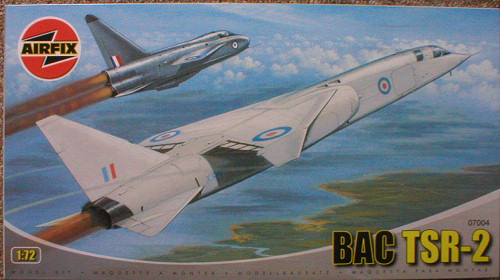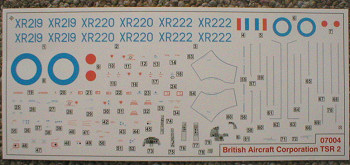
| KIT: | Airfix 1/72 TSR.2 |
| KIT #: | 7004 |
| PRICE: | £19.99 |
| DECALS: | Three options |
| REVIEWER: | Jeff Eddy |
| NOTES: | At last, an injected TSR.2 |

| HISTORY |
What was to be the one of the greatest accomplishments in the British aircraft industry (well, the post-war consolidated industry anyway) ended up being one of the greatest examples of political wrangling, mud-slinging, and mismanagement the aviation world has ever seen. The amount of time and money that was wasted during development (nearly 60 people attended a meeting concerning the labeling of switches in the cockpit!) ended up feeding the arguments of those politicians wishing to see the program killed off and the Royal Air Force buying “more-advanced” U.S-built F-111s instead. The TSR.2’s test pilots, Roland Beamont in particular, praised the aircraft for its performance, handling characteristics, and obvious ability to perform the mission for which it was designed, tactical low-level strike and reconnaissance, claiming that it exceeded theirs and the engineers’ wildest expectations.
The idea for the aircraft was formulated in G.O.R. (General Operational Requirement) 339 issued in March of 1957 as a replacement for the Canberra bomber (which is STILL in service with the RAF in the photo-reconnaissance role). Original submissions included the English Electric/Short P.17A/P.17D combination which saw the advantage of having the proposed aircraft given a short-take-off-landing (STOL) capability. In order to accomplish this, the planned aircraft, the English Electric P.17A was mounted on top of the Short P.17D, a VTOL aircraft design which resembled nothing more than a triangular landing platform with 44 vertical lift engines, 16 tilting engines, and 10 lift/propulsion engines. Needless to say this overly complex idea didn’t take off (pun intended) but the P.17A’s basic design layout, two large turbojet engines housed within a rather lengthy, slender, fuselage, accommodating the pilot and navigator in tandem separate cockpits, topped off by a top-mounted delta wing with 60° of sweepback, was carried over into the design of the TSR.2.
| THE KIT |
 If
the TSR.2 was ever going to be kitted in injection molded form, it HAD to be
Airfix that was going to pull it off. Granted other manufacturers might have
truly gone to town with luscious detail and impeccable fit but the subject is so
utterly British only the last British kit manufacturer was ever going to take
the plunge. The production of this kit appears to have been a labor (labour) of
love for the kit designers and captures the look of the original quite
convincingly. Although I haven’t taken a micrometer to it, it certainly appears
to be accurate. The designers certainly had the best reference in the world
with the two remaining examples being within a few hundred miles of Airfix’s
offices.
If
the TSR.2 was ever going to be kitted in injection molded form, it HAD to be
Airfix that was going to pull it off. Granted other manufacturers might have
truly gone to town with luscious detail and impeccable fit but the subject is so
utterly British only the last British kit manufacturer was ever going to take
the plunge. The production of this kit appears to have been a labor (labour) of
love for the kit designers and captures the look of the original quite
convincingly. Although I haven’t taken a micrometer to it, it certainly appears
to be accurate. The designers certainly had the best reference in the world
with the two remaining examples being within a few hundred miles of Airfix’s
offices.
Unlike the other TSR.2s models that have been produced (resin, vacuform, and a forgettable short-run injection molded one), the fuselage is molded in two, complete, vertically split halves as opposed to vertically split front and rear fuselage sections which are then combined to make a complete fuselage like most Tornado and F-14 kits. The moldings are typical for most recent Airfix offerings, the white plastic (what else?) features a very smooth finish and recessed panel lines that although not as crisp as say Hasegawa’s are still very acceptable and not overdone.
The cockpit features the standard equipment: separate rudder pedals, control column, bulkheads, instrument panels and two ejection seats that are accurate in shape but sorely lacking in detail. The seats are however perfectly acceptable if the kit is finished with the canopies closed. The same goes for the cockpit which utilizes the same approach as Airfix’s Gloster Javelin, namely decals for the side consoles and multiple ones for the instrument panels. These may work well provided the builder remembers to use a gloss finish on the cockpit and trims the decals close to the image so that the carrier film doesn’t interfere with the fit in the limited space on the panels, especially the navigator’s.
The fuselage comprises five parts including the aforementioned two main halves, and three parts for the upper and rear fuselage. A weapons bay with optional fuel tanks or a large “nuke” bomb is provided as well as nicely detailed main and nose gear wells. The landing gear is nicely detailed and includes separate scissor links for the nose and main gear units. Of particular note is how well Airfix managed to capture the look of the complex splayed main gear although the strength of the assembled unit appears questionable (one is reminded of their 1/72 Tornados). The intakes are nicely done and comprise three pieces each, splitter plate with intake bullet, cowling, and interior ducting. I’m curious as to how much if any filler is going to be needed when these are attached to the fuselage. I guess the experience of having built numerous F-4 Phantom models over the years has conditioned me to expect less than perfect fit when side-mounted intakes are present. A nice touch on the clear sprue alongside the separate canopy parts are the intake-mounted camera fairings which were present on the second prototype XR220.
 The decals include markings
for the three airframes that were actually completed, XR219, the one that logged
all of the TSR.2’s flight time, XR220 which currently resides at the Cosford
Aerospace Museum, and XR222 which is housed at Duxford. The fact that two of
the airframes are still in existence and restored to nearly the same condition
as they were on the date of the program’s cancellation in 1965 has allowed
Airfix to include a nearly every stencil found on the aircraft. Granted if one
chooses not to model one of the prototypes, Xtradecals recently released some
“what-if” decal sheets that depict the TSR.2 as it may have appeared if it had
in fact gone into service with the RAF. The sheets have apparently sold out of
their initial printings but with the popularity that this kit is generating they
may be back for a second printing, hopefully.
The decals include markings
for the three airframes that were actually completed, XR219, the one that logged
all of the TSR.2’s flight time, XR220 which currently resides at the Cosford
Aerospace Museum, and XR222 which is housed at Duxford. The fact that two of
the airframes are still in existence and restored to nearly the same condition
as they were on the date of the program’s cancellation in 1965 has allowed
Airfix to include a nearly every stencil found on the aircraft. Granted if one
chooses not to model one of the prototypes, Xtradecals recently released some
“what-if” decal sheets that depict the TSR.2 as it may have appeared if it had
in fact gone into service with the RAF. The sheets have apparently sold out of
their initial printings but with the popularity that this kit is generating they
may be back for a second printing, hopefully.
| CONCLUSIONS |
I’ll admit that I was extremely jazzed when I heard that Airfix was FINALLY going to produce this plane. I had owned a rather elaborate resin kit with loads of white metal goodies and photo-etched parts back in the early 90s but as I had never tackled a resin kit before it wound up sitting in my closet until sold at an IPMS meeting years later. Unfortunately this was in the years before eBay and online auctions so I possibly disposed of a true collector’s item, oh well live and learn.
I have heard that Airfix has planned on keeping this kit as a limited release only. With the initial orders selling out immediately thanks to pre-orders, I would be surprised if any kits actually made it to the store shelves. The pre-orders can’t possibly represent all of the folks out there who wanted to get their hands on this kit. This kit could become the biggest cash cow that Airfix has seen in quite a while and to discontinue production after a short run would seem almost counter-productive. Think of the numbers that the Cosford and Duxford gift shops would sell alone!
I’m planning on beginning construction of it shortly and if it’s anything like previous Airfix kits I’m expecting a bit of a challenge in getting parts to fit properly (that multi-piece fuselage looks particularly ominous). Regardless, it will go together a lot more easily than any of the kits that came before it and will most likely be THE kit to have if one wants a TSR.2 on their shelves.
| REFERENCES |
“TSR-2 Phoenix or Folly” by Frank Barnett-Jones, GMS Enterprises, 1998. – a very thorough history of the background, development, production, and cancellation of this incredible plane. Highly recommended.
“Wings of Fame” Volume 4. A very nice photo-intensive article that offers a condensed version of the information contained in the Barnett-Jones book.
TSR2 - The Untold Story, DD Video. A great video that is unfortunately available only in the European/UK PAL format (although it is well worth the money to get it converted to a US/Canada friendly NTSC)
March 2006
If you would like your product reviewed fairly and quickly by a site that has over 300,000 visitors a month, please contact me or see other details in the Note to Contributors.